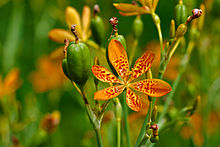Iris domestica, commonly known as leopard lily,[2] blackberry lily, and leopard flower, is an ornamental plant in the family Iridaceae.[3] In 2005, based on molecular DNA sequence evidence, Belamcanda chinensis, the sole species in the genus Belamcanda, was transferred to the genus Iris and renamed Iris domestica.[4]
| Leopard flower | |
|---|---|

| |
| Iris domestica growing in Pittsburgh, Pennsylvania | |
| Scientific classification | |
| Kingdom: | Plantae |
| Clade: | Tracheophytes |
| Clade: | Angiosperms |
| Clade: | Monocots |
| Order: | Asparagales |
| Family: | Iridaceae |
| Genus: | Iris |
| Species: | I. domestica
|
| Binomial name | |
| Iris domestica (L.) Goldblatt & Mabb.
| |
| Synonyms | |
| |
Description
editA perennial herb, I. domestica may grow to a height of 0.6–1 metre (2 ft 0 in – 3 ft 3 in), with its rhizomes in shallow ground, extending horizontally.[3] It has 3-5-stems and 8–14 leaves per stem growing in a fan, with flowers ascending proximally having orange-red scattered spots of darker pigment, blooming during summer.[3] The seed pods open in the fall, showing clusters of black, shiny seeds whose resemblance to those of a blackberry gives the plant its common name, "blackberry lily".[3] The plant is hardy to USDA plant hardiness zone 5 and is propagated by seeds or division.
In the wild, it grows in grasslands, pastures, forest clearings, meadows, and mountainous regions or shrublands.[3] Although it has escaped cultivation in many regions, it is not considered to have potential as an invasive species.[3]
Synonyms
editIts synonyms are Epidendrum domesticum L., Vanilla domestica (L.) Druce, Belamcanda punctata Moench, Gemmingia chinensis (L.) Kuntze, Ixia chinensis L., Morea chinensis, and Pardanthus chinensis Ker Gawl.)
-
Flower petals
-
Seed pod
-
Seed pod
Distribution
editThe plant is native to Eastern Asia and has been cultivated worldwide in subtropical and temperate climates.[3][5] Due to the ornamental value of its attractive flowers, the plant was distributed to Europe as early as the 18th century and the United States and Caribbean countries in the 19th century.[3]
Uses
editI. domestica is a common ornamental plant in private and public gardens, zoos, and floral displays.[3] Its flowers provide nectar and pollen to insects and birds.[3] The plant has been used in traditional medicine.[3]
See also
editReferences
edit- ^ "Iris domestica (L.) Goldblatt & Mabb. is an accepted name". theplantlist.org (The Plant List). 23 March 2012. Retrieved 17 December 2014.
- ^ English Names for Korean Native Plants (PDF). Pocheon: Korea National Arboretum. 2015. p. 371. ISBN 978-89-97450-98-5. Archived from the original (PDF) on 25 May 2017. Retrieved 26 January 2017 – via Korea Forest Service.
- ^ a b c d e f g h i j k "Iris domestica (blackberry lily)". CABI. 22 November 2019. Retrieved 17 December 2021.
- ^ Goldblatt P, Mabberley DJ (2005) Belamcanda Included in Iris, and the New Combination I. domestica (Iridaceae: Irideae). Novon: A Journal for Botanical Nomenclature: Vol. 15, No. 1 pp. 128–132
- ^ "Iris domestica". Plants of the World Online, Kew Royal Botanic Gardens. 2017. Retrieved 17 December 2021.
Bibliography
edit- Pink, A. (2004). Gardening for the Million. Project Gutenberg Literary Archive Foundation.